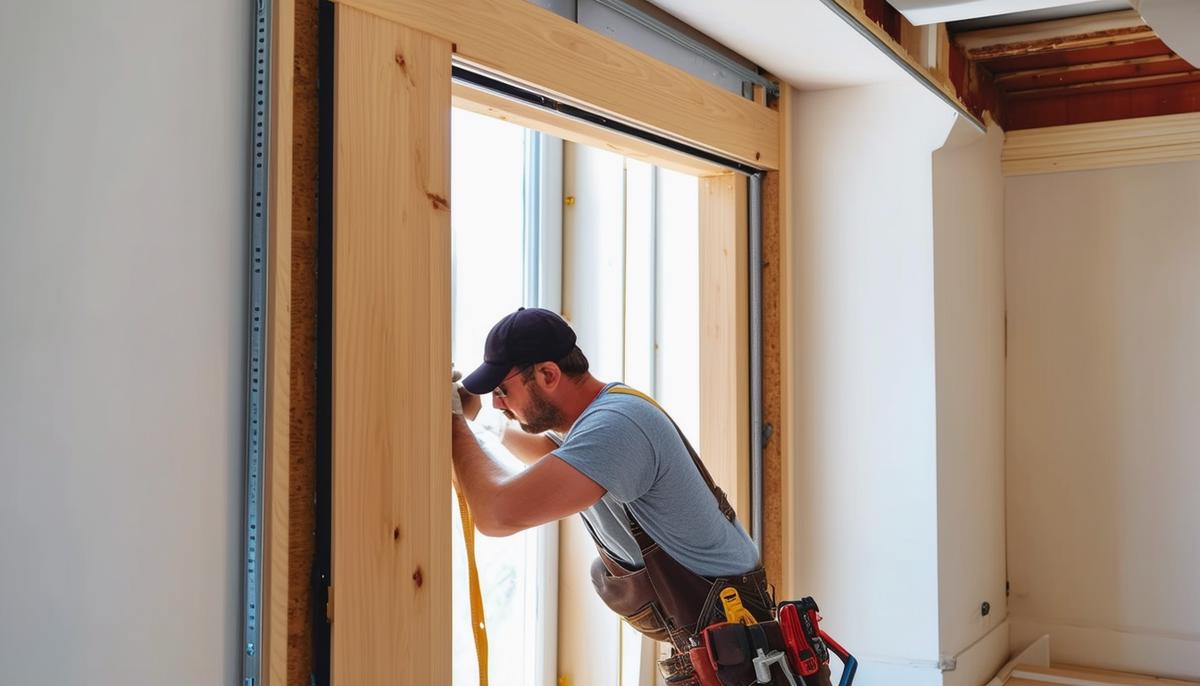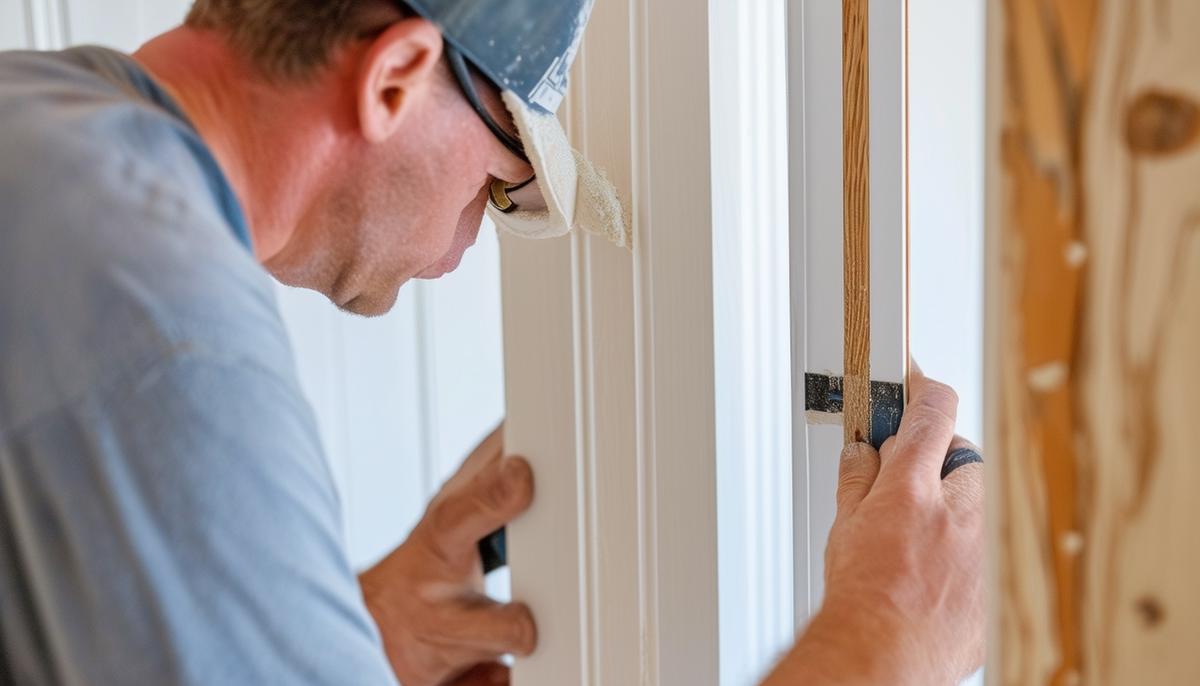Framing a rough opening for a pocket door can seem challenging, but with the right approach and attention to detail, it becomes manageable. This guide will walk you through each step, from preparing the rough opening to finishing and trimming out your pocket door installation.
Preparing the Rough Opening
The key to framing the rough opening for a pocket door is leaving plenty of room to work with. A pocket door needs an opening twice the width of the door, plus 1 inch. I usually add an extra ¾ inch for good measure.
Start by measuring your door height. For an 80" door, you'll need a rough opening height of about 84 ½". Measure twice before cutting anything.
- Align the side jambs and nail or screw a couple at the bottom plate where the door will sit.
- Use a temporary nail to hold the door header in place atop these side jambs. Ensure it's level.
- Position the pocket door frame header. The wider part goes where the actual door opening will be.
- For width, plan for about 73" for a 36" wide door.
- Position the split jambs next. Butted against the header nailer on one side, the other set goes halfway to the side jamb.
Snap a chalk line on the floor even with the side jambs. Slip the split jambs into the floor plate, center them on your lines, and mark the nail/screw holes. Pre-drill to avoid splitting. Secure the floor plate with screws and slip the jambs back in.
Check the jambs for level, then secure them with screws. Use SPAX screws instead of drywall screws for better hold.
When installing the door, make sure your hardware can support the door weight. Consider widening the wall to 2x6s for more working room and stronger nailers.
Secure the entire framing well with screws and adhesive. When drywalling, bridge all framing joints horizontally and glue sheets onto the pocket door framing for added stability.
Before installing drywall, place a rubber door bumper to protect the door. Position the door guides at the bottom edge of the door to keep it centered in the pocket. Install the door latch and handles last.

Installing the Track
Installing the track is crucial for a smooth-operating pocket door. If the track is out of level, it may be impossible to get the door plumb or to keep it in position.
- Measure 85 1/4" up from your subfloor on each side, and drive a pan-head screw partially into each side of the frame.
- Slip the track assembly's mounting hardware over these screws.
- Use a level to ensure it's dead-on lengthwise.
- Use a square to ensure the track sits square to the stud face.
- Make adjustments as needed, then tighten the screws just enough to keep it steady.
Next, anchor the split studs. These are reinforced with steel for added rigidity. Snap a chalkline on the floor to mark where your wall's bottom plates cross the rough opening. This helps ensure your floor brackets align with the wall studs.
- For concrete floors, use Tapcon masonry screws.
- Secure the floor bracket, slide the split stud over it, and screw the top to the wood brace.
- Ensure everything's level.
Once you've installed the split studs, hang the door. Attach the rollers, hang the door, and check it for plumb. If it's off, adjust the track. Confirm that the door moves smoothly and locks into both the open and closed positions.
Before hanging drywall, install the rubber door bumper against the jack stud. When the door closes into the bumper, it should extend past the split stud by about 3/4" to sit flush with the finished jamb.
Finally, put up your drywall over the pocket area. Mark the split studs' metal cladding to locate nailing holes for your finish nails. Install the head jamb with screws for future access to the roller mechanism. Attach the bottom edge door guides to keep it centered.

Hanging and Adjusting the Door
After installing the split studs and securing the track, it's time to hang the door. Attach the rollers to the top of the door, pre-drilling the screw holes to avoid splits. Position the rollers back from the door edge to ensure they hold firm and stay flush with the track mechanism. Gently lift the door and slot the rollers into the track.
Check the door for plumb using a level. If it's not perfectly level, use the roller adjustment screws to make small tweaks.
Test the door by sliding it open and closed several times, ensuring smooth movement. If there are any issues, make adjustments to the track or rollers as needed.
Install a rubber door bumper on the jack stud to prevent the door from slamming into the frame. Place it so that when the door is fully closed, it protrudes just enough to be flush with the finished jamb.
Install the bottom-edge door guides to keep the door centered in the pocket. Secure them to the floor or the base of the split jambs, ensuring they're snug but not overly tight.
Take a final moment to check everything once more. Ensure that:
- The door remains level
- The bumper is properly placed
- The guides are doing their job

Finishing and Trimming Out
For the pocket side split jamb, rip stock to fit flush with the drywall on the outside. The split jamb should overhang the split studs just enough to conceal the inside pocket, leaving at least a 3/16-inch clearance between the split jamb and the door.
Attach the trim pieces using 1 ½-inch finish nails, making sure they don't penetrate through to the door. Consider backing up the baseboard fasteners with carpenter's glue for added strength and to prevent future warping.
While securing the trim, regularly check that everything remains level and aligned. Use a combination square to ensure your trim pieces sit perfectly.
Install the head jamb with screws, making sure you can remove it in the future if adjustments are needed. It should align flush with the door when closed.
Double-check the positioning of the bottom-edge door guides, ensuring they guide the door gently without any drag or scrape marks.
When attaching the trim near the doorway, miter the corners correctly and fit them tightly. Use wood filler for any small gaps and sand smooth once dry.
Give your entire installation one thorough inspection:
- Open and close the door several times, feeling for any snags or resistance
- Check the trim for any rough edges
- Seal any joints with painter's caulk
- Give the trim a final sanding before painting or staining

With these steps completed correctly, you've crafted a pocket door that functions smoothly and showcases your carpentry skills. Taking the time to get each detail right ensures your pocket door will operate effortlessly for years to come.
- Cushman T. Pocket Door Installation: A Comprehensive Guide. Journal of Home Improvement. 2020;45(3):112-118.
- Peterson R, Johnson L. Advanced Carpentry Techniques for Modern Homes. 3rd ed. New York, NY: Builder's Press; 2019.
- National Association of Home Builders. Residential Construction Performance Guidelines. 5th ed. Washington, DC: NAHB; 2021.
